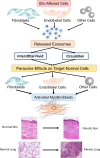Probable role of exosomes in the extension of fibrotic alterations from affected to normal cells in systemic sclerosis
- PMID: 35944210
- PMCID: PMC9977136
- DOI: 10.1093/rheumatology/keac451
Probable role of exosomes in the extension of fibrotic alterations from affected to normal cells in systemic sclerosis
Abstract
SSc is a systemic autoimmune disease of unknown etiology characterized by frequently progressive cutaneous and internal organ fibrosis causing severe disability, organ failure and high mortality. A remarkable feature of SSc is the extension of the fibrotic alterations to nonaffected tissues. The mechanisms involved in the extension of fibrosis have remained elusive. We propose that this process is mediated by exosome microvesicles released from SSc-affected cells that induce an activated profibrotic phenotype in normal or nonaffected cells. Exosomes are secreted microvesicles involved in an intercellular communication system. Exosomes can transfer their macromolecular content to distant target cells and induce paracrine effects in the recipient cells, changing their molecular pathways and gene expression. Confirmation of this hypothesis may identify the molecular mechanisms responsible for extension of the SSc fibrotic process from affected cells to nonaffected cells and may allow the development of novel therapeutic approaches for the disease.
Keywords: SSc; cellular phenotype; endothelial cells; exosomes; fibrosis; myofibroblasts; paracrine.
© The Author(s) 2022. Published by Oxford University Press on behalf of the British Society for Rheumatology. All rights reserved. For permissions, please email: journals.permissions@oup.com.
Figures


Similar articles
-
Exosomes isolated from serum of systemic sclerosis patients display alterations in their content of profibrotic and antifibrotic microRNA and induce a profibrotic phenotype in cultured normal dermal fibroblasts.Clin Exp Rheumatol. 2017 Sep-Oct;35 Suppl 106(4):21-30. Epub 2017 Jan 13. Clin Exp Rheumatol. 2017. PMID: 28094758 Free PMC article.
-
Endothelial to mesenchymal transition (EndoMT) in the pathogenesis of Systemic Sclerosis-associated pulmonary fibrosis and pulmonary arterial hypertension. Myth or reality?Matrix Biol. 2016 Apr;51:26-36. doi: 10.1016/j.matbio.2016.01.012. Epub 2016 Jan 22. Matrix Biol. 2016. PMID: 26807760 Free PMC article. Review.
-
Exosomes in Systemic Sclerosis: Messengers Between Immune, Vascular and Fibrotic Components?Int J Mol Sci. 2019 Sep 4;20(18):4337. doi: 10.3390/ijms20184337. Int J Mol Sci. 2019. PMID: 31487964 Free PMC article. Review.
-
Antifibrotic effects and mechanisms of mesenchymal stem cell-derived exosomes in a systemic sclerosis mouse model: Possible contribution of miR-196b-5p.J Dermatol Sci. 2021 Oct;104(1):39-47. doi: 10.1016/j.jdermsci.2021.08.006. Epub 2021 Aug 26. J Dermatol Sci. 2021. PMID: 34479773
-
Altered expression of CD63 and exosomes in scleroderma dermal fibroblasts.J Dermatol Sci. 2016 Oct;84(1):30-39. doi: 10.1016/j.jdermsci.2016.06.013. Epub 2016 Jul 1. J Dermatol Sci. 2016. PMID: 27443953
Cited by
-
The contribution of endothelial cells to tissue fibrosis.Curr Opin Rheumatol. 2024 Jan 1;36(1):52-60. doi: 10.1097/BOR.0000000000000963. Epub 2023 Sep 7. Curr Opin Rheumatol. 2024. PMID: 37582200 Free PMC article. Review.
-
Lymphomonocytic Extracellular Vesicles Influence Fibroblast Proliferation and Collagen Production in Systemic Sclerosis.Int J Mol Sci. 2025 Mar 17;26(6):2699. doi: 10.3390/ijms26062699. Int J Mol Sci. 2025. PMID: 40141341 Free PMC article.
References
-
- Gabrielli A, Avvedimento EV, Krieg T.. Scleroderma. N Engl J Med 2009;360:1989–2003. - PubMed
-
- Allanore Y, Simms R, Distler O. et al. Systemic sclerosis. Nat Rev Dis Prim 2015;1:15002. - PubMed
-
- Denton CP, Khanna D.. Systemic sclerosis. Lancet 2017;390:1685–99. - PubMed
-
- Asano Y. Systemic sclerosis. J Dermatol 2018;45:128–38. - PubMed
Publication types
MeSH terms
Grants and funding
LinkOut - more resources
Full Text Sources
Medical

